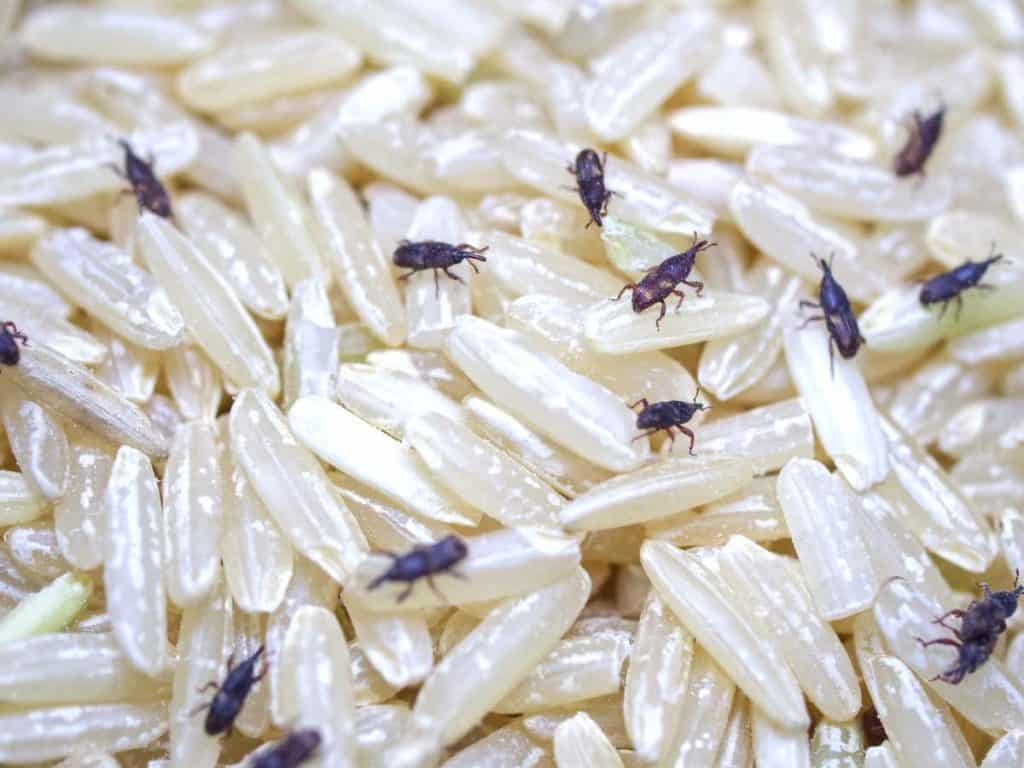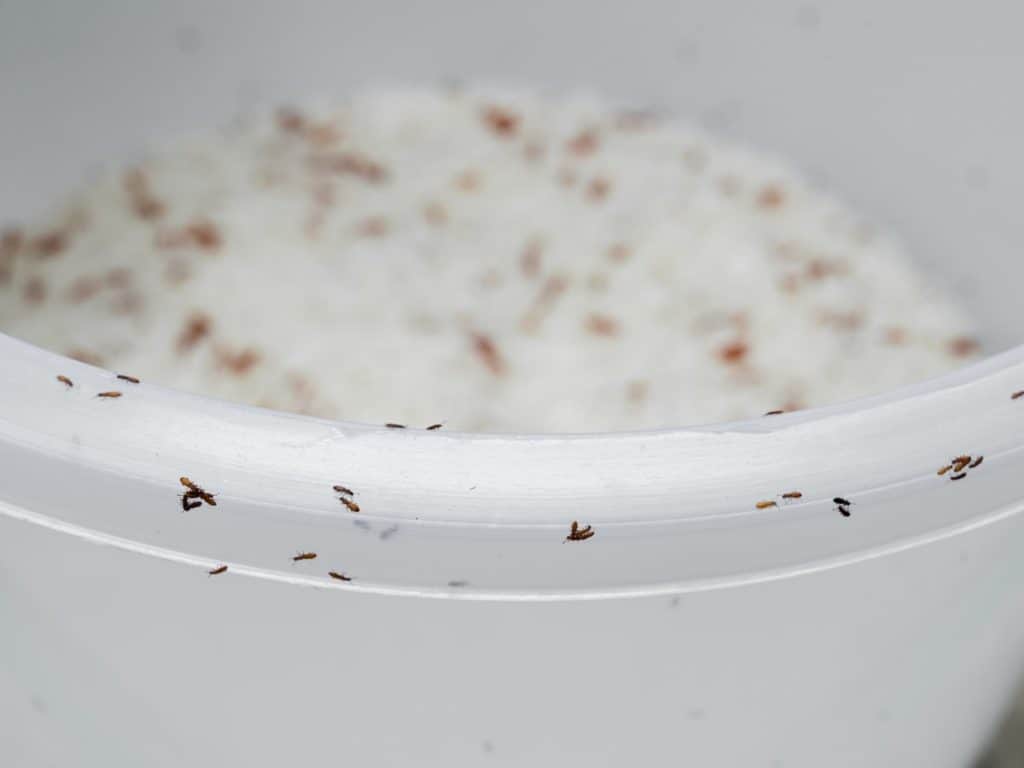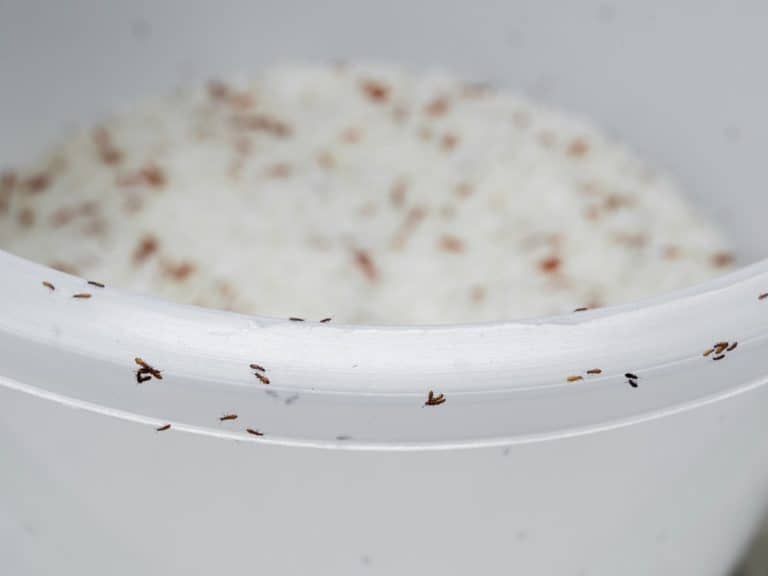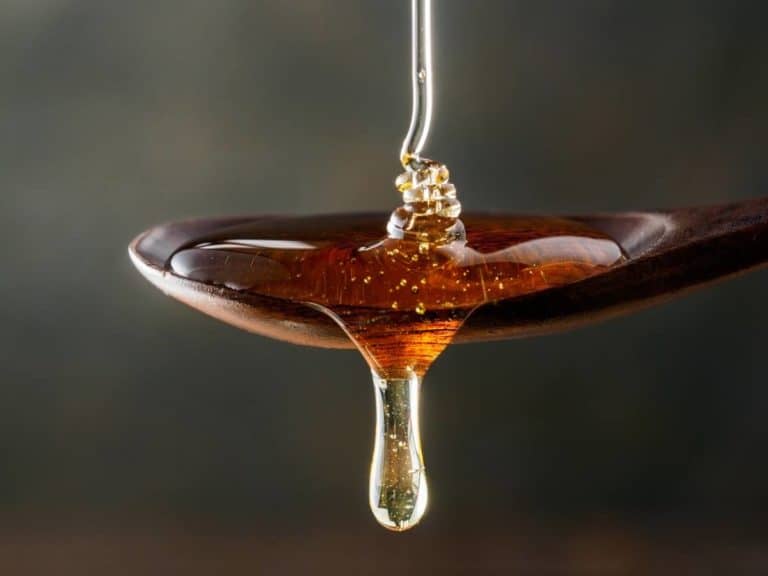How to Remove Insects from Almonds, Peanuts, Walnuts, And Cashews
“Ew! Gross!” yelled my kids when I showed them the insides of my just-opened bag of almonds. Not only was there a movement among the nuts, now there was an explosion of little winged critters.
These were Indian meal moths, which were only one of many kinds of bugs that infest almonds and other nuts. Indian meal moths so common now they’re often simply called pantry moths. They are part of the whole category of bugs to watch out for called SPI’s, stored-product insects.
The easiest method of removing insects from almonds, peanuts, walnuts, cashews, and other nuts at home is freezing for 3-4 days in a freezer. Another effective method of eliminating insects in nuts is baking them in an oven at 140 F for an hour.
Stored-product insects come from several families of moths, beetles, and mites that all live and feed on dried vegetable and animal products especially seeds.
Some feed on them in both adult and larval form, while some of the most widespread such as the moths don’t eat as adults, but their young more than make up for it with their voracious appetites.
These bugs get into your food in many ways, and at any stage from the farm to the store and even from within your own pantry. Adult insects will lay their eggs on the food itself or its packaging, and these eggs will hatch whenever the conditions are right for them.
The larvae then get into your food, as many kinds can chew their way through cartons and plastic bags. They’re so widespread, so tiny and so prolific there’s no permanent solution against them.
The good news, however, is that these bugs share mostly the same weaknesses with each other. What kills or prevents infestations of one kind will work for the others.
What Stored-Product Insects Eat

Stored-product insects infest a wide range of dried foods, as many of them are capable of chewing through and digesting various products such as whole nuts. Some specialize only in broken or crushed grains and seeds, but can infest bags of whole nuts since there’s always some nuts that get broken or crushed in shipping in each bag.
When they begin reproducing, SPI’s can easily spread to and infest the other items in your pantry. In other words, the bugs you found in your almonds may have come in via your rice or breakfast cereal and may spread to your raisins next.
Knowing what SPI’s eat will help you identify potential sources of infestation and to protect your other foods and vulnerable products.
Here’s a list of what stored-product insects or their larvae like:
- Nuts – almonds, cashews, walnuts, peanuts, macadamias, hazelnuts, etc.
- Whole grains like rice
- Flours and baking mixes
- Breakfast cereals
- Popcorn
- Dried legumes – beans, lentils, chickpeas, etc.
- Dried fruits – raisins, prunes, dates, etc.
- Bread
- Biscuits and cookies
- Chips
- Chocolate
- Candies
- Powdered milk
- Bouillon cubes
- Spices, especially whole spices like coriander seeds
- Dried vegetables and herbs
- Birdseed
- Dry pet foods
- Decor made of dried plant matter, e.g. Christmas decor made of pine cones
Monitor your supplies of all these, as many stored-product insects can readily transfer from feeding on one item to another.
What Kinds of Insects Infest Nuts
The commonest pests found in nuts are Indian meal moths and several kinds of seed-eating beetles.
However, depending on your location or the origin of your product, there are quite a few other insects that you may find in your food or pantry, such as drugstore beetles, and larder beetles that normally go for animal proteins but will also eat nuts.
Here’s a list of the commoner kinds of SPI’s that may infest nuts, along with short descriptions:
Indian Meal Moths
Indian meal moths are also called pantry moths.
They are small, slim moths, and are easily recognized by their wing colors. The base of the Indian meal moth’s wings, which is near the head, is gray or tan, while the rear parts of the wings are reddish-brown with dark bars. The larvae are off-white and grow up to 1/2 inch long.
All food damage is inflicted solely by the larvae, as the adults do not eat. Indian meal moth larvae in addition to their skin castoffs and feces contaminate food with their webbing. Infested food will look like it has cobwebs on it.
Indian meal moths will infest any kind of dried food. Because they are so common, and the adults are good fliers, infestations can come from seemingly out of nowhere.
Almond Moths
Almond moths, also called tropical warehouse moths, are recognized by their light grayish-brown wings, with the hind edges of the wings having fringes.
Almond moths are named for infesting almonds, but they like dried fruit even better. Infestations of nuts can thus come from infested containers of raisins and the like.
All damage they cause is from their larvae, as the adults do not eat. Like the Indian meal moth, the short-lived adults of almond moths exist only to mate and lay eggs. In addition to contaminating food with feces and skin castoffs, almond moths leave large amounts of webbing on food.
Stored Nut Moths
The stored nut moth is a small, slim brown moth native to Southeast Asia but is spreading due to international trade. Its larvae feed on a range of oily seeds like walnuts, almonds, and soybeans.
Sawtoothed Grain Beetles
Sawtoothed grain beetles are very small, reddish-brown to dark chestnut beetles.
If you look at them with a magnifying glass you will recognize them by the sawtooth-like spikes on either side of their middle or thoracic section. Both the adults and grubs are voracious feeders on grains, cereal products, and nuts.
Merchant Grain Beetles
Merchant grain beetles are small, reddish-brown to dark chestnut relatives of sawtoothed grain beetles, and also have saw-toothed thoracic spines. They will consume a wide variety of dry vegetable products including grains and nuts.
Red Flour Beetles
Red flour beetles are tiny, flat-bodied, fast-scurrying, dark reddish-brown beetles.
Both adults and grubs have rather weak jaws, so they feed on damaged grains or milled grain products like flour. However, they can also infest packs of nuts that contain crushed or broken pieces, and packages of nut flour.
They have a distinct, unpleasant medicinal odor and foul the flavor of food, and this can cause stomach upsets if the food is eaten.
Because adult red flour beetles are highly active and are good fliers, they can spread easily all around your kitchen and even invade from outside.
Confused Flour Beetles
Confused flour beetles are a relative of the red flour beetle, and at first glance they look and behave exactly alike.
You can only tell them apart by looking closely with a magnifying glass or microscope, and their similarities often confuse entomologists, thus their name. Like red flour beetles, confused flour beetles not only contaminate their food, they also give off a bad, medicinal odor and foul the flavor of food.
Bean Weevils
Bean weevils are a family of tiny, round-bodied beetles that infest the insides of seeds like beans and nuts. An adult will lay its eggs on a bean or nut, and the larvae upon hatching dig their way in where they will spend most of their lives, emerging only to breed.
Bean weevils may occasionally be found inside nuts, but just as often what you’ll find are the hollowed-out nuts that remain after the adult insects have flown away.
Rice Weevils

Rice weevils are tiny, reddish-brown beetles with long snouts and pale spots on their wing covers.
Like bean weevils, most of the damage they cause is by their larvae dwelling inside grains and nuts. You may find nuts with larvae still inside, or the hollowed-out shells left behind when the rice weevils mature and fly away.
These insects are good flyers, and so able to spread out and infest new areas easily.
Drugstore Beetles
Drugstore beetles got their name from infesting various kinds of herbs back from when drugstores usually sold these instead of the processed and packaged medicines we now use.
Drugstore beetles are oval, light brown, or tan insects with no visible head, as their heads are hidden under the foreparts of their shells.
Drugstore beetles can easily chew their way through cartons, plastic bags, and even aluminum foil. Their infestations can be recognized by the multitude of small, round holes that the adults chew to exit from packages of food.
These beetles infest a very wide range of products, from dried herbs and spices to cereals, chips, and nuts. Most of the damage is caused by their larvae, as the adults eat little or not at all in their short lives. However the adults are strong flyers, so this pest spreads easily.
Cigarette Beetles
Cigarette beetles are relatives of drugstore beetles, and have digestions strong enough to consume tobacco despite the toxicity of nicotine.
However, they will also eat and contaminate a wide variety of foods such as grains and cereal products, coffee beans, spices, nuts, and dried fruits. They strongly resemble drugstore beetles, save for having a glossier shell.
Like drugstore beetles, they also have strong jaws and can chew through cartons and plastic bags. Infestations are easily recognized by the small, round holes the adults chew to exit from packages.
Khapra Beetles
Khapra beetles are now considered one of the world’s worst insect pests, and some of the strict food importation laws in countries like Australia are aimed at preventing their introduction.
These beetles from India are oblong with brown, very hairy-looking wing covers and silvery markings. They consume grains and cereal products, dried fruits, nuts, and many other kinds of dried animal and vegetable products.
Cowpea Weevils
Cowpea weevils are oval, brown beetles with black spots on their wing covers and the rear of the abdomen, which sticks out beyond the wing covers. They infest a wide variety of legumes such as lentils, beans, chickpeas, and peanuts.
Related Post: How to Salt Unsalted Peanuts Already Roasted
Warehouse Beetles
Warehouse beetles are small oblong beetles, dark brown with yellow or light brown markings on their wing covers. They are a highly common pest in the southern states.
They feed on many kinds of grain and cereal products, beans and nuts, but since their mouthparts are weak they will only go after milled products, or broken or crushed seeds.
The hairs of warehouse beetle larvae can cause stomach or respiratory irritation if ingested.
Larder Beetles
Larder beetles are small, dark brown beetles with a broad band of yellow or lighter brown across the upper portion of the wing covers.
These bands are marked with three black dots in a triangle pattern on each wing. While larder beetles prefer to feed on dried animal products such as dried meat and fish, they can also be attracted to high-protein vegetable products such as some grains and nuts.
Grain Mites
Grain mites are any of several related mite species that infest grains and other dried vegetable foods including nuts and nut meal or nut flours. These are tiny gray arthropods, barely visible to the naked eye, and are arachnids with eight legs, not insects.
Grain mites not only contaminate food with their feces and castoff skins, but they also produce allergens that bother many sensitive individuals, spoil the flavor and aroma of food, and can cause digestive upsets when eaten. Some even bite, causing an allergic reaction known as “baker’s itch.”
What Harm Can Insects in Nuts Do
None of the stored-product insects mentioned above are toxic.
Chances are you’ve already consumed your share of them, as insect parts and insect by-products are ubiquitous in food. The FDA’s safety standards allow for a certain amount of insect matter to be present in food, as they’re almost totally unavoidable.
You can safely eat most lightly infested foods. That said, there are good reasons to throw away any food infested by SPI’s due to the changes they cause in the food.
Taste, Aroma, and Texture Changes
Insects living in your food not only consume it, but they also defecate in it, molt in it leaving their castoff skins, and some of them will inevitably die then decompose in it.
Moth larvae also create webbing that not only physically makes food look disgusting, they also attract and stick to moisture and insect wastes that can harbor harmful bacteria.
The activity of large numbers of insects also produces heat, and this combined with the moisture of their castoffs and excrement can create a breeding ground for molds and bacteria.
These by-products can drastically change the taste and aroma of food, making them unpalatable and even causing digestive upsets.
The physical damage caused by insects also breaks down whole seeds like nuts and grains into powder, which leads to an unpleasantly dusty or mushy texture when the food is eaten.
Upset Stomach from Insect-Generated Substances
Some insect by-products are either upsetting to the stomach in themselves or cause such nausea when consumed that they induce vomiting or diarrhea. For example, the chemical given off by red flour beetles and confused flour beetles can cause diarrhea and gas in those with sensitive digestion.
Allergies
Insect chitin and secretions, and the molds they cause to proliferate in infested food, can trigger allergic reactions. Flour mite bites can cause a dermal allergy called “baker’s itch.”
How to Get Rid of Insects in Nuts
If you find insects in a bag of nuts, the quickest way to get rid of them is to simply close the package again and dispose of it in an outdoor garbage can. This keeps the insects from escaping to infest the other items in your pantry.
If you just purchased one bag of nuts, then chances are the infestation is limited to that new package.
However, if you found the insects in nuts that have been in your cupboard for a while, there’s a good chance the bugs have spread to other foods as well. A thorough inspection of all your stored foods and other susceptible items is then necessary, followed by a thorough cleaning.
Inspect the Pantry
Inspect your entire pantry and all its contents. Look for signs of infestation such as spilled food residues, packages that leak or have visible holes, and packages with unusual, unpleasant odors.
Shake transparent packages and look closely to spot crawling beetles or larvae. Check the cabinet doors and cabinet linings for flying or crawling insects, particularly adult Indian meal moths.
Make sure to also inspect other products that are susceptible to SPI infestations, such as birdseed and pet food. If you have any house decor made of dried plant material, inspect these also.
Get Rid of Insects by Freezing
Stored-product insects and their eggs are killed by prolonged exposure to freezing temperatures. Freeze suspected packages of food for 3-4 days to kill most SPIs.
Get Rid of Insects by Heat
Non-flying insects and the larvae and eggs of all SPI’s can be killed by baking or toasting seeds and nuts.
This could render very lightly infested foods palatable enough to eat. You can bake nuts and the like in an oven at 140 F for an hour, or toast in a wok until lightly browned or fragrant. The toasted products can be bottled once cooled for later use.
Toasting however is best as a preventive measure, especially for nuts and seeds purchased from open-air displays.
Dispose of Infested Food
Infested food should be disposed of immediately and in ways that will protect the rest of your pantry. Re-close packages of infested food to minimize escapes, then bag all infested packages in a garbage bag then tightly tie it up. Place the garbage bag immediately in the outdoor garbage can.
If your infested nuts or grains contain no flying insects, you may also consider giving the neighborhood wildlife a feast. Many birds will relish both the nuts and the insect grubs in them, as will squirrels.
Clean the Pantry
After disposing of all infested food packages, empty the pantry and give it a thorough cleaning with a vacuum cleaner. Remove and throw away cabinet liners as insects may hide in them.
Use Pantry Insect Traps
Many brands of pantry insect traps are now available.
These are usually glued paper traps that have been scented with the sex pheromones of the targeted insect. Try to identify what insects are causing your infestation and get the appropriate traps. If unsure, you can set traps for the commonest pantry pests in your area. Chances are the Indian meal moth is one of these.
Note however that these traps only take out the adult insects. You will still have to manually inspect all food and other susceptible product packages and containers to get rid of the larvae.

Spray the Pantry
While it’s not recommended to spray insecticide in food storage areas, sometimes this is necessary to control widespread infestations especially of flying SPI’s.
Remove all foods from the pantry then spray the pantry with permethrin-based insecticide to kill wandering adult insects. Observe all precautions on the bug spray label.
Flour beetles and Indian meal moths, and other active insects, can easily spread when disturbed so check windowsills, doorways, and all crevices for escaped insects and spray them. Allow the insecticide to dissipate before replacing food containers in the pantry.
Do not spray any food containers or packaging unless you’re going to throw them away.
How to Prevent Insects in Nuts
An ounce of prevention is not only worth a pound of cure, it can also save a ton of nuts. The best way to keep stored-product insects from your pantry is to make sure all your foods and other susceptible products are properly stored and to thoroughly inspect food packages at the store before buying.
Inspect Packages Before Buying
Always inspect packages of food for damage and signs of infestation before buying. If you find signs of infestation, try getting a package from a higher shelf. Alert the store management of leaking packages and other signs of insect infestation so they can act to contain it.
Transfer Food Into Sealed Containers
Because many SPIs or their larvae are capable of chewing through carton and plastic bags, dried foods packaged in these should immediately be stored in sealed plastic or glass containers and covered tightly. Clear containers should be preferred, as these allow you to easily spot infestations.
Cook Raw Nuts Immediately
Raw nuts should be cooked as soon as possible. This prevents any insect eggs already on them from hatching and prevents them from being found by wandering adult SPI’s. Better yet, have a schedule of dishes you want to cook with nuts before purchase so you don’t forget to use them.
Consume Nuts Within Two Months
Nuts and other dried foods should not be allowed to sit too long in the pantry, as this gives more time for eggs already on them to hatch, and for wandering adults SPIs to spawn on them. The recommended maximum holding period is two months.
If you need to stock supplies for a longer period, make sure to repack nuts purchased in bulk securely.
Use Up Older Foods First
Use up older opened packages of nuts, seeds, cereals, and the like first before opening new ones. The longer an opened package of food is left in the pantry, the more likely it is for eggs already in it to hatch or for adult insects to find their way into it.
Do not mix old and new foods in the same container. You could either be introducing an infestation or giving more food for an infestation in your old food that’s just waiting to break out.
Clean the Pantry Regularly
Clean the pantry regularly with a vacuum cleaner. Do not leave empty cartons inside the pantry, as some SPIs can live on paper when no other foods are available, and these may also harbor eggs.
Repel Insects With Herbs or Essential Oils
Dried bay leaves, cloves and garlic can be scattered through a pantry to repel stored-product insects.
This helps protect your food from infestation by wandering adult SPI’s, but not from eggs, larvae, and adults that are already inside your food packages. Another natural method is to wipe the cupboard interior with a white vinegar solution.
Certain essential oils like citronella have similar effects.
However, laboratory experiments have found these natural remedies aren’t one hundred percent effective, so don’t neglect to inspect and clean regularly.
My husband, however, claims to possess a foolproof technique for preventing insects from getting at our nuts: he just makes the nuts disappear first!





